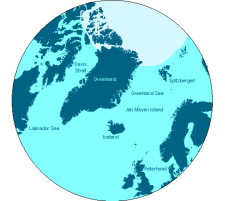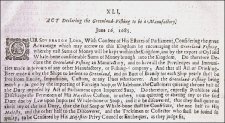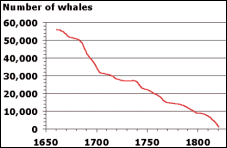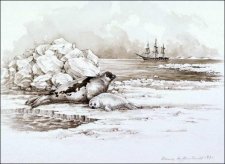| The end of the bowhead in the Greenland Sea |
In 1596 William Barents discovered the Arctic island of Spitzbergen lying far to the north and to the east of Greenland. Ten years later the explorer Henry Hudson visited the area whilst in search of the elusive north-west passage and discovered a large population of bowhead or Greenland right whales Balaena mysticetus. For the next 250 years this stock of whales was hunted without mercy, or much fore-thought, and by the 1820s the stock had been taken from an original population of about 65,000 whales to the very brink of extinction. Today, no bowheads swim in the Greenland Sea. In 2001 Robert Allen and Ian Keay published a paper (see reference at the bottom of this page) in which they argued that the Greenland Sea stock of bowheads was exterminated because of a rapid increase in the productivity and efficiency of British vessels after about 1750. In the paper they developed a model to reconstruct the size of the original whale population and to chart the course of its demise. How was it that the whalers were able to force this population to extinction? One might have expected that as the stock of whales fell the cost of finding them would increase to the point that the venture was uneconomic. Why was this not the case with the Greenland bowhead fishery? One possibility was that government intervention allowed whaling to continue even after it had become uneconomic. Both the Dutch and British governments encouraged whaling, by means of subsidies, to ensure that there was a ready source of trained seamen to be pressed into their navies in time of war. Such subsidies may have allowed whaling to continue even when it was unprofitable thus driving the population to very low levels and eventually to extinction. Allen and Reay suggest an alternative scenario. A large Dutch fleet operated in the Greenland Sea from the mid 1600s to around 1800. Throughout this period the population of bowheads declined only slowly and showed some signs of becoming a sustainable industry. It was only with the entry of the British in the 1750s that the stock began to decline dramatically. By 1803 the Dutch had abandoned the fishery as uneconomic, but the British continued to hunt the whales until extinction. The reason they could do so, Allen and Reay argue, was because their superior vessels and tactics led to a very high level of productivity. Consequently they earned more revenue and profit per ship than did the Dutch, pushing up their price/cost ratios to a level at which extinction of the whales became a commercial proposition. In addition, the British whaling vessels did not just take whales, they also killed large numbers of seals, ensuring that their voyages were profitable even when few or even no whales were taken. This alternative harvest ensured that whales continued to be hunted even when they had become reduced to very low densities indeed. In his inaugural address to the 1883 London Fisheries Exhibition Thomas Huxley proclaimed:
How very wrong he was! Reading: Allen, R.C. and Keay, I. (2001) The first great whale extinction: The end of the bowhead whale in the eastern Arctic. Explorations in Economic History 38: 448-477. |




